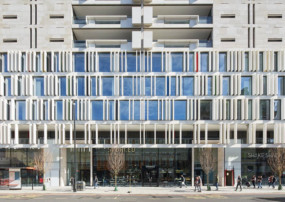
In 2017 London has seen the completion of about 46,500 new build residential units across the city. This is still short of overall real housing demand (over 64,000 homes required), but while some developments sell out in a matter of weeks, others tend to linger on the market, leading us to pose the question, why? The common thread linking successful schemes is a superior quality of design. Design, quality and true value for money is increasingly becoming more important than location. Buyers are willing to look further out if they get the right quality of product. To achieve this, developers and designers use dedicated craftsmen to design globally leading interiors.
Rory Cramer, Head of Consultancy at Marsh & Parsons New Homes division feels strongly that developers can no longer create “cookie cutter” schemes aimed at the many rather than the few. He says, “Buyers of new build properties in London are more discerning than ever, they want the highest quality coupled with exquisite craftsmanship. We always advise using best in trade craftsmen to ensure show-stopping design that will stand the test of time and that owners will be proud to show off.”
Quality craftsmanship
Ian Bayliss co-founder of interior designer Bowler James Brindley, behind many leading residential and hotel schemes including the newly refurbished W-Hotel in Barcelona and One Crown Place in London says, “Quality craftsmanship can really bring a development to life. Every designed apartment or commercial space should tell a story and take the viewer on a journey. We use world-class artisans who are the best in their trade to conjure bespoke pieces of furniture. Our aim is to compliment the overriding theme of each development, emphasise the originality and give it a specific edge.”
One such craftsman who has been making waves across London is South African born Justin Van Breda. Bowler James Brindley invited him to create bespoke furniture at one of the penthouses at Nova, a development in Victoria. Stepping out of his usual comfort zone of more traditional pieces Justin collaborated with Bowler James Brindley and made a 1970’s inspired bar which was wrapped in leather, featured elements of brass and was set off by the large perforations in the bar front. Stephen Crawley co-founder of interior designer Bowler James Brindley says, “The whole building is quite out there in that, in our opinion, it’s a reinterpretation of 1960s and 1970s architecture, there are lots European Modernist influences and what Justin achieved with the bar is straight out of a Scott Fitzgerald novel. The overall objective was to bring about a rich feeling of rock and roll and to evoke the characters changing the paradigms in London in the late 1960s and early 1970s. ”
Local sourcing
Bowler James Brindley also places an emphasis on “local sourcing”. Bayliss explains: “What we might use in one development could be totally different from the next as the audiences who buy in different locations can vary and different things resonate with them. For example at One Crown Place it is our intention to use local silk manufacturers and we have used London based furniture makers at the Nova Penthouse.”
Traditional craftsmanship can span all of the elements of new build construction and design. Mount Anvil is one such developer who places huge emphasis on skill and quality. Their new development in Vauxhall, Keybridge is one such example. Rory Cramer of Marsh & Parsons continues; “Mount Anvil used a material (brick) that we are familiar with and is typical to
London architecture and design but in a contemporary way. The brick buildings designed by Allies and
Morrison create a sense of familiarity and warmth that glass and steel struggle to provide. But they have taken this material to a new level and built the tallest brick building in Europe at 37 stories high.”
Lucy Southall co-founder of Bowler James Brindley concludes; “Authentic craftsmanship at new residential developments is only going to become more important. Interior designers should work closely with developers to suggest the best in field from the exciting global pool of highly skilled talent.”











